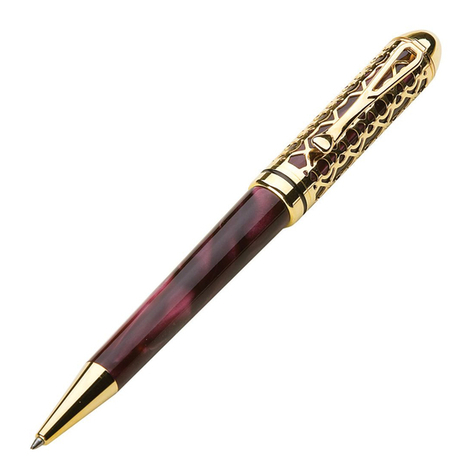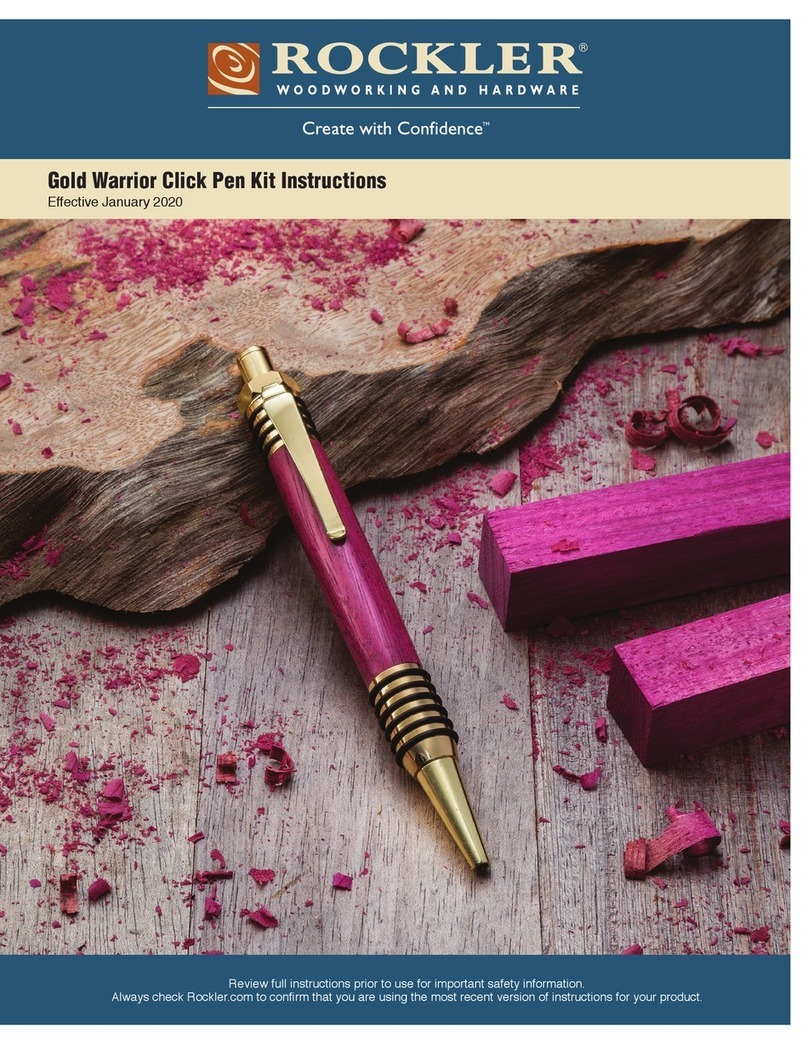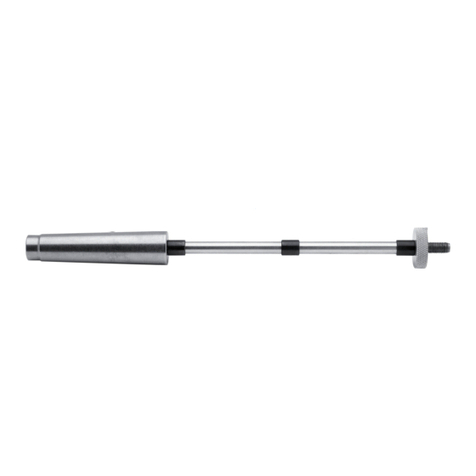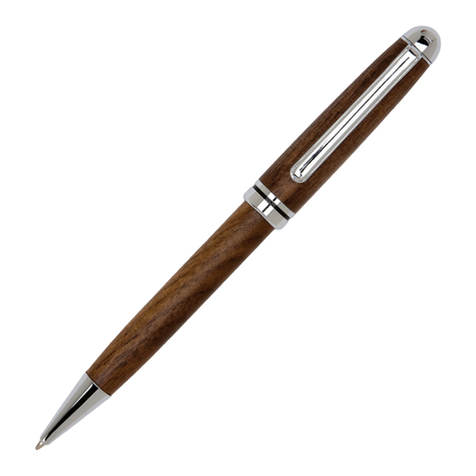Rockler Platinum Cuban Pen User manual

Review full manual instructions prior to use for important safety information.
Always check Rockler.com to conrm that you are using the most recent manual version for your product.
Platinum Cuban Pen Kit Instructions
Effective December 2018

2
GENERAL SAFETY WARNINGS
This product is designed only for specific applications as defined in the instructions and should not be modified or used for any
manner not described in these instructions. Use only recommended accessories. Before using the Platinum Cuban Pen Kit: READ,
UNDERSTAND and FOLLOW ALL INSTRUCTIONS AND SAFETY WARNINGS. KEEP THESE INSTRUCTIONS READILY
AVAILABLE FOR FUTURE REFERENCE.
> Always confirm that you are using the most recent version of
the Instructions and safety warnings for your product (see the
Instructions link on the product page at Rockler.com).
> Before using another tool with this product, always read,
understand and follow the instructions and safety warnings
in the owner’s manual for that tool. If you do not have the
owner’s manual, obtain one from the tool’s manufacturer
before using it with this product.
> Before using any chemical with this product, always read,
understand and follow all safety warnings and guidelines in
the manufacturer’s Safety Data Sheet (SDS; formerly called
“MSDS”), especially regarding:
• How to safely use the chemical, including potential hazards
and recommended first aid measures;
• Personal safety equipment required to safely use the
chemical (e.g. gloves, eye protection, mask/respirator, etc.);
• Proper and safe handling, storage and disposal of
the chemical.
> Before using this product, review and verify that all tools to be
used with it have safety equipment installed and are in proper
working order as defined by the tool’s owner’s manual.
> Do not use this product until you have read and are
confident you understand:
• Blank Preparation (p. 3);
• Turning the Blank (p. 3);
• Assembly (p. 4).
> The user assumes all risk and responsibility for the proper and
safe use of this product and for ensuring product suitability for
the intended application.
> It is the sole responsibility of the purchaser of this product to
ensure that any anyone you allow to use this product reads
and complies with all instructions and safety precautions
outlined in this manual prior to use.
> Follow all standard shop safety practices, including:
• Keep children and bystanders away from the tool
operating area;
• Do NOT use power tools in explosive environments, or in
the presence of flammable liquids, fumes or dust;
• TURN OFF AND UNPLUG all power tools BEFORE
making any adjustments or changing accessories;
• Remain alert and use good judgment. Do not use this
product if you are in any way impaired by medications,
alcohol, drugs or fatigue;
• Keep your work area well lit and clean;
• Dress appropriately. Secure loose clothing, remove all
jewelry and tie up long hair before using this product;
• ALWAYS wear safety glasses, hearing protection
and respiratory protection that complies with
NIOSH/OSHA/ANSI safety standards;
• Use dust collection tools and dust face masks to
reduce exposure to dust;
• Use safety equipment such as featherboards, push
sticks and push blocks, etc., when appropriate;
• Maintain proper footing at all times and do not overreach;
• Do NOT force woodworking tools.
> These warnings and instructions do NOT represent the total
of all information available regarding tool safety, use and
technique. Always seek out opportunities to learn more
and improve your skills and knowledge.
Drilling, sawing, sanding or machining wood
products can expose you to wood dust, a substance known
ot the State of California to cause cancer. Avoid inhaling
wood dust or use a dust mask or other safeguards for
personal protection. For more information go to
www.P65Warnings.ca.gov/wood.
Danger indicates a hazardous situation that, if not avoided, will result in death or serious injury.
Warning indicates a hazardous situation that, if not avoided, could result in death or serious injury.
Caution indicates a hazardous situation that, if not avoided, may result in minor or moderate injury
or property damage.
Notice indicates important or helpful information and/or user tips.
BP0918

3
Blank Preparation
1. Cut the blanks about 1/8” longer than the Brass Tubes to
allow for blowout or hole elongation. (The Lower Tube is the
longer of the two.) Maintain grain orientation of the two blanks
for turning by drawing a line lengthwise across the cut line.
2. Drill the blanks with a 10mm drill bit at a speed of about
750 RPM.
3. Scuff the Brass Tubes with 220 grit sandpaper to remove
oxidation and roughen the Tubes for better adhesion.
4. Prepare to glue with medium cyanoacrylate (CA) glue or
two-part fast-drying epoxy.
5. Working on one at a time, apply the glue to the outside of the
Brass Tubes, with a liberal amount around the ends that will
be inserted first. Do not apply glue to the inside of the blank,
as this will cause the glue to get inside the Brass Tubes and
ruin the tube.
6. Insert each tube with a twisting motion into the blank until
the tube is equidistant between both ends of the blank. Wipe
off any excess glue on the ends of the blank. Allow the
glue to cure.
7. Using a barrel trimmer or a disk or belt sander, trim the ends
of the blanks until you can just see the bright brass ends of the
tubes. The faces of the ends must be perpendicular to the
Brass Tubes and parallel with each other. It is imperative that
the length of the trimmed blanks match the original length of
the Brass Tubes and that the insides of the Brass Tubes are
clean and free of any glue.
8. Use a permanent marker to make marks inside the Brass
Tubes that line up with the grain-alignment lines you drew
on the outside of the blanks. This will help you maintain
grain continuity after the blanks have been turned. Fig. 1.
Turning the Blank
1. Assemble the blanks on the mandrel with the bushings.
Mandrel Setup. Keep the grain orientation of the blanks in
line when mounting. Each bushing has a step that is designed
to be inserted into the Brass Tubes for stability while turning,
as the inner diameter of the tubes is larger than the mandrel.
2. Tighten the tailstock and then tighten the mandrel nut that
holds the blanks. Do not over-tighten the tailstock or mandrel
nut as this may cause the mandrel to flex, causing the blanks
to go out of round.
3. Turn the blanks to the desired shape, making sure that the
surfaces next to the bushings are turned to the same diameter
as the bushings.
4. After turning, sand the surfaces in progressive steps of 240,
320, 400 and 600 grit. If a higher finish is desired, Micro-Mesh
abrasives may be used.
5. Apply the finish of choice and polish.
6. Remove the blanks from the mandrel, taking care to maintain
blank orientation and grain alignment.
Mandrel Setup
Fig. 1
Place a small piece of painter’s tape
around the blanks toward the center onto which you can
transfer the grain-alignment marks from inside the tubes.
Upper Tube Lower Tube
Nut
11.7mm13.4 mm
14.5mm
12.1mm
Mandrel
Cuban Pen Bushings

4Distributed by Rockler Companies, Inc.
Medina, MN 55340
44127
Rev 12/18
Check Rockler.com for updates. If you have further questions, please
contact our Technical Support Department at 1-800-260-9663
or support@rockler.com
Assembly
1. Use a pen press or a clamp to press the Cap/Clip (1) into
the top end of the Upper Tube (2). Keep in mind that the
top end was next to the outer bushing when the blanks
were on the lathe.
2. Press the Center Band Coupler (3) , sleeve end first, into the
bottom end of the Upper Tube (2). (The bottom end of the
Upper Tube was toward the center when the blanks
were on the lathe.)
3. Press the Tip (7) into the bottom end of the Lower
Tube (6) (which was next to the other outer bushing
on the lathe).
4. Press the non-threaded end of the Twist Mechanism
Coupler (5) into the other end of the Lower Tube (6).
5. Slide the Spring (9) over the writing tip of the Ink
Cartridge (8) and insert both through the Twist Mechanism
Coupler (5) and into the Lower Tube (6).
6. Thread the Twist Mechanism (4) onto the Twist Mechanism
Coupler (5). If the writing tip has been exposed, turn the Twist
Mechanism Coupler (5) to retract it.
7. Align the grain of the two pen sections and press them
together until the Center Band Coupler (3) is tight against the
Twist Mechanism Coupler (5).
Stock #
Pro Pen Turning Mandrel, #2 Morse Taper 49514
Pro Pen Turning Mandrel, #1 Morse Taper 44309
Adjustable Pen Turning Mandrel, #2 Morse Taper 48377
Adjustable Pen Turning Mandrel, #1 Morse Taper 44341
Fisch 10mm HSS M2 Pen Drill Bit 37216
Cuban Pen Bushings 54645
Barrel Cleaner/Pen Mill Kit 47526
OPTIONAL ACCESSORIES
1 Cap/Clip
2 Upper Tube
3 Center Band Coupler
4 Twist Mechanism
5 Twist Mechanism Coupler
6 Lower Tube
7 Tip
8 Ink Cartridge
9 Spring
PARTS LIST
1
2
3
7
6
5
4
8
9
This manual suits for next models
1
Other Rockler Accessories manuals























